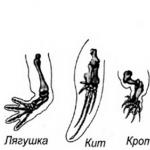Celery root is used in the preparation of some dishes. The tubers contain protein and minerals, and the leaves contain many vitamins. In addition to its medicinal properties, celery has a beneficial effect on metabolism, causing increased appetite.
Celery is a heat-loving plant with a very long growing season (180 - 240 days). It is demanding on the content of nutrients in the soil, needs frequent watering, especially on light sandy-loamy soils, and does not tolerate drought. Celery is fertilized mainly with manure, compost, and during the growing season - with mineral fertilizers. The presence of chlorine in the soil does not affect celery.
In open ground in beds, celery is grown only from seedlings. Growing seedlings is an extremely complex process that only experienced vegetable growers can do. Seeds for celery seedlings should be sown in January - early February in bowls or boxes. The seeds gradually germinate. The emerged plants at the cotyledon leaf stage are planted at a distance of 3 cm from each other, and after a few weeks, as they grow, they are transplanted again at a distance of 8 cm from each other into deeper boxes or into open ground in a greenhouse. With each transplant, the roots of the plants are shortened by about 1/3 - 1/2. Celery seedlings are very sensitive to cold, so they require “hardening off” with frequent ventilation in early May before planting.
Seedlings are planted in the second half of May in well-fertilized soil. Its roots are shortened again and planted shallowly in the ground, on an area of 30 x 30 cm. The crops are regularly watered until they take root.
During the growing period, celery requires careful care. In addition to regular loosening of the soil and abundant watering, celery should be fertilized, best with urea diluted in a ratio of 1:8. Until the end of July, celery should be regularly fertilized at intervals of two weeks with ammonium nitrate with calcite (30 g per 1 m2), as well as a combined fertilizer (100 g per 1 m2). It is advisable not to pick off the leaves of the plants, as this reduces the yield. It is not recommended to dig up the soil around the tubers and clean the roots from small roots so that they are smooth, or trim them. Some varieties of celery produce roots at the bottom of the tuber. Removing soil from celery tubers only makes sense if planted deeply.
Celery should be harvested in a timely manner, before the first autumn frosts. It is dug out with a shovel or fork-shaped shovel, the tops are unscrewed and the soil is shaken out between the roots, slightly shortening them. Place celery in the cellar on damp sand, otherwise the tubers dry out quickly.
Preface
Celery is one of the most useful vegetables, because it contains a lot of microelements, vitamins, amino acids and essential oils that the body needs. Having grown this crop on their plot, gardeners think about when to harvest the vegetable and how to store it so as not to lose its valuable properties.
When to Harvest All Types of Celery
The root and petiole varieties of celery are often preserved
There are three types of celery: root, leaf and petiole. Growing a useful crop in your own garden beds is half the battle. It is important to choose the right way to store it in order to preserve the beneficial qualities of the vegetable for as long as possible.
Root
In autumn, the root of the vegetable increases its mass and also gains all its basic beneficial properties.
This type of celery can remain in the soil almost until the first snowfall, but the tubers cannot be frozen. If the root crop is affected by frost, this will negatively affect the taste of the vegetable, as well as its shelf life.
But you shouldn’t dig up the tubers ahead of time either, since the concentration of nutrients in them reaches its maximum precisely when the first snow arrives. Therefore, harvesting of the root crop occurs approximately in mid-October. However, gardeners must, of course, monitor the weather forecast so as not to ruin the harvest.
Sheet
Celery must be harvested before flower stalks appear. Otherwise, it acquires bitterness and an uncharacteristic aroma.
The leaves of this vegetable must be collected before frost, otherwise all the valuable components of the plant will be lost. The latest time when you can cut its leaves is the end of September. At this point, the concentration of vitamins and microelements in the green vegetable will be maximum.
Chereshkovy
When you need to get a harvest in the summer, preference is given to early varieties - leafy Golden Malachite, petiole - Parus, root Diamant or Apple
This type of crop is also sensitive to low temperatures, so the petioles must be cut before the first frost. As a rule, harvesting occurs in September. But if celery was grown using the trench method and it is possible to protect the stems from the cold, then the petioles are removed 3-4 weeks later.
Experienced gardeners strongly advise bleaching the rosette of stems a couple of weeks before harvesting. To do this, you need to collect the petioles in a bunch, and then wrap their lower part with paper, burlap or other material that will not transmit light, but will allow the plant to breathe. Thanks to this procedure, the petioles lose their bitterness and become more tender.
How to store celery
Depending on the type, the methods and periods for storing stocks will vary.
Root
In order to enjoy leaf and petiole celery in winter, you need to dig it up without removing the earthen lump
- If you have a basement or cellar, vegetables can be stored in these rooms in containers filled with moistened sand or peat.
- It is also practiced to “seal” root crops, when they are placed in a box, at the bottom of which there is a mixture of lime and sand, more sand is poured on top, and the container is then covered with clay. After the clay dries, the boxes are stored on shelves and racks in the basement.
- You can also store celery tubers in the refrigerator. Root vegetables must be washed, dried, packaged in cling film or bags and placed in the vegetable compartment.
- Storing tubers on the site by burying them in holes. In this case, dig a shallow hole, place root vegetables there in one layer, then sprinkle them with sand, and then with earth. But you need to take into account that this method is only suitable for areas with a mild climate, where the ground does not freeze in winter.
- Drying. The tubers are thoroughly washed and peeled, and then cut into small strips. Place on a tray and send to a cool, dry place for 30–40 days.
- Freezing. Peeled root vegetables are grated on a coarse grater, packaged in bags and stored in the freezer.
Storing in the freezer leads to the loss of the beneficial qualities of celery, so it can subsequently be consumed only after heat treatment.
Sheet
The main disadvantage of storing celery in the refrigerator is that it is not possible to accommodate the entire crop.
Leaf celery is cut with a sharp knife, leaving a shoot about 1 centimeter long from the root.
- In a refrigerator. The leaves need to be washed, dried, packaged in a plastic bag and placed in a vegetable drawer.
- Celery can be stored frozen by first chopping it and placing it in ice trays with a little water. The molds are subsequently placed in the freezer. You can also freeze greens in plastic containers to later use them as an ingredient for main courses.
- Salting. Celery leaves are placed in jars and covered with salt at the rate of 100 g of salt per 0.5 kg of leaves, after which they are rolled up and stored in a pantry or cellar.
- Drying. The washed and dried leaves are cut into small pieces, placed on a baking sheet and covered with clean paper to hide the greens from the sun's rays. After about a month, the finished spice is placed in a glass jar and stored in a dark place.
Chereshkova
- In the refrigerator, this type of crop is stored similarly to the leafy variety of vegetables. The petioles are cut, washed and dried on a napkin. Then they are wrapped in a plastic bag or aluminum foil and placed in the vegetable compartment.
- Freezing. Clean dried petioles are placed in bags and sent to the freezer. If the stems are blanched by placing the chopped product in boiling water for 2-3 minutes, then cool and dry, then with subsequent freezing the storage period of the vegetable will increase significantly.
- You can keep the petioles in the basement for a long time if you generously coat each of the stems with clay slurry, then lightly dry them and put them in stacks in a box.
- Dig up the plants, leaving a little soil at the root of each, and then “plant” them in the sand in a cool place, such as a basement.
- Drying petiole celery is similar to drying leaf crops. After cutting the petioles into small pieces, they are placed on a tray, covered with a sheet of paper and left in a cool place for about 30 days. For storage, the petioles are placed in a glass or plastic container or in a plastic bag.
Shelf life
- Root. The vegetable is stored in a living room for 4 days, on a refrigerator shelf - from 2 to 4 weeks. Buried in sand, it can be preserved for 3–6 months, and once dried, it can be preserved for up to a year.
- Leafy and petiole. These types of crops can be stored in the refrigerator for up to 10 days, in the freezer for up to 3 months, and in dried form for 1 month.
There are many ways to preserve healthy spices and they are not complicated. But we must remember that for high-quality storage of crops, it is important to remove the crop from the beds correctly and in a timely manner.
Only the lazy don’t talk about the benefits of celery. Freshly squeezed juice from the petioles is rich in vitamins and promotes weight loss, improves complexion, and has a calming effect on the nervous system. The vegetable contains carotene and is rich in valuable amino acids and microelements. If you managed to grow this crop on your plot, the question arises of when to harvest and how to store petiole celery so that it retains its healing properties and brings maximum benefits.
Juicy stems are good in fresh salads, soups, side dishes, they are used to prepare vitamin cocktails
Time to harvest
A gardener's dream is large, juicy, bleached celery stalks, sweet, with a spicy aroma, without bitterness. For it to be realized, it is necessary to observe not only the technology of planting and caring for the crop, but also the timing of harvesting petiole celery.
This vegetable crop, in contrast to the root variety, is more delicate, sensitive to temperatures below 0⁰ C. First of all, this applies to self-bleaching varieties that are grown without burying the stems in the soil or mulching material. They are cut no later than September, before the first frost. If the plant was grown in a trench method or it is possible to use covering material, the time for harvesting petiole celery can be delayed by 3–4 weeks.
Advice! Experienced gardeners recommend subjecting the rosette of stems to a special procedure - bleaching - 2-3 weeks before harvesting. The petioles are collected in a bunch and the lower part is wrapped in burlap, paper, or other opaque but breathable material. This way they will be more tender and without bitterness.
One more tip. You cannot keep the plant in the garden longer than recommended by agricultural practices; as a rule, this is from 11 to 16 weeks. Otherwise, the petioles become rough, fibrous, and taste worse.
Petiole celery is completely dug out of the ground; during harvesting, only the roots are cut off and then sent for storage. For plants intended for longer storage or growing, the roots are left and then buried in damp sand in a cellar or greenhouse.
Note! Celery varieties can have different petiole colors. Green stems are recommended to be bleached, yellow stems are more delicate, self-bleaching, pink (red) varieties are the most resistant to frost. They can be removed later.
Storage and processing methods
There are several ways to store and process stalked celery for the winter. Each of them has its own pros and cons.
In a cold cellar, the vegetable lies without loss of appearance and nutrients, but not for long - up to 2 months.
The advantage of the refrigerator is the ability to store trimmed petioles, ready for use, but the period is even shorter (2-3 weeks).
Frozen celery lasts up to a year, but you can’t make a fresh salad from it or squeeze out juice.
Dried petioles have an even longer shelf life. They retain a lot of useful substances, but are only suitable as an aromatic additive to dishes.
Thrifty housewives use different options for storing and processing stalked celery and provide their family with a healthy vegetable throughout the winter.
In a refrigerator
Vegetables purchased or picked up from the cellar for current consumption are stored in the refrigerator. The task at hand is to ensure that the stems retain their elasticity and juiciness, but do not begin to rot. Before putting them in the refrigerator, they are washed, dried, then one of the packaging options is used:
wrapped in foil;
wrap the bundle with a paper towel and place it in a plastic bag;
dry product can be wrapped in cling film.
Before consumption, the dried edges of the petioles are cut off; otherwise, they retain their original quality.
Cellar
As practice shows, it is best to store the grown crop of petiole celery in the cellar.
Before lowering it into the basement, the foliage of a dug plant is cut off, and a small piece of rhizome (2–3 cm) is left at the bottom. The sockets are placed vertically in a box, half covered with sand. Alternatively, individual specimens with roots can be buried in damp sand (peat). Instead of a basement, an unheated balcony, a cold veranda, or a glazed loggia will do, but only if the air temperature there does not drop to 0⁰ C.
Options for freezing petioles
A popular storage method is freezing stalked celery for the winter. Despite the abundance of recipes, the fundamental difference is one thing - whether to heat-treat the vegetable before freezing or not.
The first option is freezing and blanching the product. The scheme is similar to preparing Brussels sprouts, step by step it looks like this.
The petioles are washed, hard fibers (veins) are removed, and cut into small pieces.
The crushed mass is immersed in boiling water for 2-3 minutes.
Remove with a slotted spoon into a bowl of cold water or pieces of ice for quick cooling.
Before freezing petiole celery, lay it out in one layer on a cloth napkin, and after draining excess moisture, place it on a baking sheet covered with parchment paper.
Sent to the freezer.
Once frozen, transfer to a sealed bag.
The chopped stems can not be blanched, but immediately placed in bags or containers, and then frozen. But in this case, the shelf life of the workpiece is reduced to 2–3 months.
Advice! If you boil and freeze whole stalks, they can be used to make light stuffed appetizers. Suitable fillings include cottage cheese with raisins, cheese with bell peppers and herbs, and minced chicken with Parmesan.
Drying and seasoning
A time-tested way to store spices is by drying stalked celery. Selected stems are washed under running water, carefully removing sand and pieces of soil, and blotted with a cloth. Whole or cut into large pieces, lay out on a clean sheet of parchment paper, cover with another layer of paper on top and leave at room temperature until completely dry. Taking into account the juiciness of the stems, this will take about a month. Dried petioles are stored in a glass container and crushed as needed. You can immediately grind them in a mortar, grind them in a blender or twist them through a meat grinder, and use them as a seasoning.
To speed up the process, petiole celery is dried in an oven or electric dryer. The principle is the same - large pieces (2–3 cm) are placed on a wire rack and kept at a temperature of 50–60⁰ C. When dealing with the oven, do not forget to keep the door ajar so that air circulates and the product dries and does not bake.
Pickling
Our grandmothers used salt to store stalked celery. The stems, cut into pieces, were placed in glass jars and generously sprinkled with salt. It takes about 200 g for 1 kg of petioles. This preparation is used to flavor first and meat dishes, and added to hot sauces.
Harvesting and storing petiole celery:
Do you know what spring vitamin deficiency is? This means that there are no healthy products in the kitchen, and you do not know how to prepare and store celery root and other vegetables. Use our tips, and your dishes will delight the whole family with an unusual spicy taste. You need to take care of the preparations in the summer. Do not remove leaves from selected specimens onto the greens so that all nutrients are completely transferred to the underground part. For salads, it is better to grow the leafy or petiole type, and save the root vegetables for the winter.
Timely harvesting
Do not rush to remove rhizomes from the garden: when they sit in the ground for a long time, they become more mature and larger. In addition, during long-term cultivation, the surface skin acquires the necessary hardness and can protect the juicy pulp from damage during harvesting, transportation and storage. The main thing is not to miss the first frost, otherwise the celery will not store well. In the middle zone, harvesting time occurs around the end of September, and the weather forecast will help you choose more accurate dates.
About a month before harvesting, cut off the lower leaves and shoots; they have already fulfilled their function, and now the root crop will ripen on its own. To avoid damaging the peel, try not to dig the underground part with a shovel. It is better not to use any tools, but simply pull out the plant by the tops. Check the quality of the celery: when the top is soft, the tuber has begun to rot. Tap on the rhizome; when you hear a ringing sound, you can be sure that there are voids inside.
Trim the tops, leaving small stumps, remove thin roots and clean the celery from adhering soil. Sort all copies. When there are a lot of root vegetables, a few can be left in the garden. The underground part will not be suitable for food, but in early spring the plants will give you fresh leaves for salad. If you want to enjoy this greenery in winter, plant the rhizomes in flower pots and grow them in the window.

Storing root vegetables in a city apartment
Celery is not capricious, it stores well until summer, but it still requires attention. The underground parts can be kept in the refrigerator. Since there are different products there, many of which are not cooked, unsanitary conditions are unacceptable. You need to thoroughly rinse and dry the root vegetables and pack them in plastic bags. Place the tubers in the vegetable compartment; they can be used fresh for salads and added to hot dishes.
Of course, there is only enough room in the refrigerator for a small amount of roots, and if you want to eat celery all winter, you need to use other storage methods. When the container for vegetables is very small, you have to bring small portions of root vegetables from the cellar. Before putting them in the refrigerator, cover each specimen with cling film; in this form, it remains fresh and juicy for up to 10 days.
If you have a large freezer in your home, do not load your entire crop into it. When celery tubers are stored at sub-zero temperatures, they are unsuitable for food in their raw form. Place only root vegetables in the freezer, which will become raw materials for soups and vegetable stews.

Wintering celery in the cellar, garage, or country house
There are many ways to store fresh celery tubers. Choose any of them, but remember: a good result is obtained only when the room temperature is from 0° to +1°, and the humidity is 90% or higher. Our great-grandmothers also knew how to organize the wintering of root crops in non-residential buildings, and these methods have hardly changed. Take advantage of the wisdom of old advice.
- Pour a layer of wet sand into a large box and “plant” celery there, like in a garden bed.
- Dip the root vegetables in a “mash” of clay and water, dry and store in stacks.
- In the southern regions, where the ground does not freeze to great depths, place the tubers in trenches, sprinkling each layer with wet sand. Cover the vegetables with straw and a 15 cm layer of soil on top.
For fresh consumption, select only the largest, smoothest, healthiest specimens. Ruthlessly discard those root vegetables that cause even the slightest suspicion. They will not go to waste if you immediately put them into processing and store them frozen or dried.
Use some other little tricks to better preserve your harvest. When chalk and lime are added to the sand where root crops are stored, or the rows of celery are sprinkled with onion peels, the crop does not rot. Make sure that the sand does not dry out; to do this, you can cover the pile with film, but do not make airtight packaging. It would be a good idea to put the vegetables in plastic bags or boxes lined with film. This material retains carbon dioxide, which contributes to the good preservation of tubers. In any case, the top of the container must be open or have ventilation holes.

Waste-free technologies
You've sorted out the good root vegetables, look at what specimens are left:
- small;
- ugly;
- damaged;
- with voids;
- rotten.
Don’t rush to throw them into the compost heap, respect your work. Good owners will make everything work. When you collect the discarded tubers in a bag, put the cut thin roots in there - they can also be put to good use.
Peel the root vegetables, separate the rotten areas, cut the pulp into strips and dry. In a closed container, such a product will be stored for a long time. Add it to soups: once boiled, celery will give the broth a piquant taste. You can grind the pieces in a coffee grinder and use the powder as a seasoning. You can use cut roots in the same way.
Another way: finely chop or grate the peeled pulp. Place the resulting mixture into bags and place in the freezer. To make your subsequent work easier, divide the product into portions needed for cooking. In winter, all you have to do is take out the bag and, without defrosting, put the contents into the pan.
Summer is coming to an end, when the family ate fresh vegetables and herbs with appetite, but you want to keep a similar menu for the winter. There is nothing complicated: give celery root vegetables a little care, and they will be fresh, healthy and juicy until the summer. Until the new harvest, there will be vitamin-rich dishes on the table, and you won’t even remember about spring ailments.
What is the difference between root, stalk and leaf celery?
It is grown for its thick root, which can reach 700 g. Leaves from root celery are not cut off. This species has the longest growing season - from February to September or even October. Therefore, it is grown only through seedlings. Remember: celery root is not spudned!
Petiole celery produces juicy long thick stems. They are ready for cutting by the end of summer. In order for the petioles to be bleached, tender in taste and not bitter, the plant must be carefully hilled up without covering the growing point. It is also grown through seedlings, and the growing season for petiole celery is shorter than for root celery, which means we sow it a couple of weeks later.

Rice. 2. Petiole celery. Photo bagheera123.
grown for its very useful leaves, which can be cut all summer. This type of celery is the most frost-resistant. It can be grown either through seedlings or by direct sowing into the ground at the earliest possible time, even in Siberian conditions.

Which celery seeds are better to plant - fresh or old?
Oddly enough, celery seeds that have been stored for 3-4 years will sprout much more quickly than fresh ones.
Celery root varieties: Russian size(weight up to 1.5 kg), Esaul, the Giant of Prague(up to 800 g), Egor, Anita(the pulp does not darken during heat treatment), Albin, Diamant, Maxim, Yudinka, Makar, Royal Night.
Sheet: Cheerfulness.
Chereshkovy is better to choose “self-bleaching” varieties.

Rice. 4. Most often these are varieties of foreign breeders. Photo irusik322.
What varieties of celery should not be planted?
Mouse writes that “It is better not to plant Gribovsky and Yablochny, they will be very small, if at all.”
dgina agrees with her: “Apple does not produce large turnips at all, or rather to say that there are none at all, just a washcloth.”
When to sow celery in Siberian conditions?
The root one is sown in early February, and the petiole one - at the end of February. Leaf - in the first half of March.
Peza notes: “If you sow the petioles together with the root ones, then you need to harvest them much earlier, otherwise the petioles become coarser. So as not to be too early (there’s already enough to do), I’m thinking of sowing later, on the 20th of February.”
If you sow leaf celery in the ground, bypassing the seedling stage, then, according to the advice Argentina, you can sow at least in mid-April, at least later.
Do I need to soak celery seeds before sowing?
Despite the fact that the seeds are very small, it is very advisable to soak them for a day, since “celery seeds contain essential oils that inhibit germination,” writes stewardessa. “Before sowing, the seeds must be rubbed with your hands to destroy this shell. Just don’t overdo it!”
The water should be warm, about 30 degrees. Sova007 soaks it like this: “I soaked it, as written, overnight at 30C - I put a liter jar of water on the battery with the seeds right in the plastic bag in which the seeds were sold. I just picked holes with a needle. They sprouted in a week.”
Ratta prepares seeds for sowing as follows: “Wash the seeds in water with a temperature of +60. We soaked it in this water for an hour and drained it. And so 3 times. Then sow. It will rise quickly."
Elena_ plants in two ways: “I’ll soak it in Epin, put it in a rag, so that later it’s convenient not to catch it,” and also “according to Kizima’s method - on the snow, and when the snow melts, I’ll sprinkle it with AVA fertilizer.”
knv2002 clarifies: “Be careful with Epin. It cannot be used in large concentrations. It then begins to oppress the plants. Here you must strictly follow the instructions. This year I’m using NV-101 together with Epin, I like it better, since it also has power. This is the same extract as Epin, but only from the conifer complex.”
Olga N. I used another stimulant: “I soaked celery in Zircon, then dried it, even accidentally forgot it for 10 hours, then sowed it dry. Came up on the 4th day. Shoots on the package were frightening on the 20th. Zircon is an extract from Echinacea.”
How to sow wet seeds then?
We spread the seeds not very thickly, about 5-6 per 1 cm groove. The depth of the groove is small, about 1 cm.

Rice. 5. The crops here are very dense. Photo Hexe.
There is no need to sprinkle the seeds with soil. You can water from above using a wet sponge, squeezing a thin stream out of it. Until germination, you need to keep the bowl with the seeds at a temperature of 18-20 degrees in the light, covered with glass or transparent film. The soil should not be dry and a crust should not form.
Is it possible to sow celery in peat tablets?
Answers Lula2007.80: “You shouldn’t waste pills on celery. He is tenacious and can withstand picking very well.”
When do shoots appear?
Recipes with celery
Many people don’t grow celery because they don’t know where it can be used in cooking. Siberian moms posted several recipes and gave advice on how to use this extremely healthy vegetable.
Pushina shares a trick for salting tomatoes: “I highly recommend salting tomatoes to everyone with celery greens. No other spices are needed. However, I also add garlic. Try at least a jar and you will become a fan of this method of pickling! Delicious!"
Salad recipe from Anna Kovalenko: “Apple + celery (grated), you can also add carrots and other vegetables. I pour honey and lemon on it for the baby. My husband likes the same thing with shrimp.” She also recommends adding celery to soups, especially legumes, and vegetable stews.
Recipe for a “man’s” salad from Peza: “Celery, apple, ham, onion (I use leek), cheese - all in strips, cheese on a coarse grater, mayonnaise.” And Peza herself prefers to eat celery in this form: “I really love it with tomato or kiwi and honey. In a blender with an apple (kiwi) and honey, or with your own tomato juice.”
A couple more salad recipes from Lenik: 1. “The simplest salad: pine nuts + canned pineapple (cut into small cubes) + grated (coarse) celery root (proportions are arbitrary). Salt. Season with mayonnaise or sour cream with mayonnaise, as you like. The second recipe is more complicated due to the larger number of ingredients: grated celery root + pickled cucumbers (straws) + pickled mushrooms (I made it with boletus) + any smoked meat (bacon or smoked sausage or smoked chicken - your choice). We also add salt and pepper, if desired, and again season with sour cream or mayonnaise with sour cream.”
Aulchanka offers this salad: “Celery, carrots, apple - everything on a fine grater, and whoever eats mayonnaise - with mayonnaise, but we prefer sour cream or olive oil.”
Ledyru gave a simple recipe: “Our whole family loves celery, it’s so delicious in a salad with cucumbers and tomatoes.”
You can also freeze celery and add it to stir-fries and soups during the winter.
Celery for weight loss
Peza shares a recipe for a diet sandwich: “Celery is a very dietary product; it has a negative calorie content. My husband loves celery and apple sandwiches.” She also gives a simple recipe for celery mass: “I brought it home, put it in a blender with tomato and salt, and enjoyed it all evening.”
More recipes with celery on our website:
11.05.16,
Nadya
Novosibirsk


















